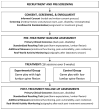Virtual immersive gaming to optimize recovery (VIGOR) in low back pain: A phase II randomized controlled trial
- PMID: 29730393
- PMCID: PMC5975386
- DOI: 10.1016/j.cct.2018.05.001
Virtual immersive gaming to optimize recovery (VIGOR) in low back pain: A phase II randomized controlled trial
Erratum in
-
Corrigendum to "Virtual immersive gaming to optimize recovery (VIGOR) in low back pain: A phase II randomized controlled trial" [Contemporary Clinical Trials 69 (2018) 83-91].Contemp Clin Trials. 2020 Sep;96:106120. doi: 10.1016/j.cct.2020.106120. Epub 2020 Aug 18. Contemp Clin Trials. 2020. PMID: 32826199 No abstract available.
Abstract
The virtual immersive gaming to optimize recovery (VIGOR) study is a randomized controlled trial of the effects of virtual reality games to encourage lumbar spine flexion among individuals with chronic low back pain and fear of movement. Whereas traditional graded activity or graded exposure therapies for chronic low back pain have high attrition and poor long-term efficacy, we believe that virtual reality games have distinct advantages that can enhance adherence and clinical outcomes. First, they are engaging and enjoyable activities that can distract from pain and fear of harm. In addition, because they gradually reinforce increases in lumbar spine flexion to achieve game objectives, continued engagement over time is expected to promote recovery through restoration of normal spinal motion. The study design includes two treatment groups which differ in the amount of lumbar flexion required to achieve the game objectives. All participants will play the games for nine weeks, and pre-treatment to 1-week post-treatment changes in pain and disability will serve as the co-primary clinical outcomes. In addition, changes in lumbar flexion and expectations of pain/harm will be examined as potential treatment outcome mediators. Maintenance of treatment outcomes will also be assessed for up to 48-weeks post-treatment. In brief, we hypothesize that the virtual reality games will reduce pain and disability by promoting spinal motion and allowing participants to develop an implicit understanding that they are capable of engaging in significant lumbar spine motion in their daily lives without a risk of injury to their back.
Trial registration: ClinicalTrials.gov NCT03463824.
Keywords: Clinical trial; Kinesiophobia; Low back pain; Virtual reality.
Copyright © 2018 Elsevier Inc. All rights reserved.
Conflict of interest statement
Conflict of interest statement
CRF and JST have read and approved the final manuscript and certify that they have no conflicts of interest or financial, personal, or other relationships that could inappropriately influence or be perceived to influence this manuscript.
Figures



References
-
- Chou R, Shekelle P. Will this patient develop persistent disabling low back pain? JAMA: the journal of the American Medical Association. 2010;303(13):1295–302. - PubMed
-
- Nicholas MK, Linton SJ, Watson PJ, Main CJG. Decade of the Flags” Working, Early identification and management of psychological risk factors (“yellow flags”) in patients with low back pain: a reappraisal. Phys Ther. 2011;91(5):737–53. - PubMed
-
- Main CJ, George SZ. Psychologically informed practice for management of low back pain: future directions in practice and research. Phys Ther. 2011;91(5):820–4. - PubMed
-
- Hides JA, Richardson CA, Jull GA. Magnetic resonance imaging and ultrasonography of the lumbar multifidus muscle. Comparison of two different modalities. Spine (Phila Pa 1976) 1995;20(1):54–8. - PubMed
Publication types
MeSH terms
Associated data
Grants and funding
LinkOut - more resources
Full Text Sources
Other Literature Sources
Medical

